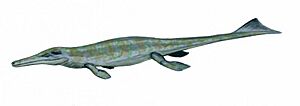Bajocian facts for kids
The Bajocian was a time long, long ago in Earth's history. It's like a chapter in a giant book about our planet's past! This age was part of the Middle Jurassic period, which was when dinosaurs roamed the Earth. The Bajocian lasted for about 2 million years, from around 170.3 million years ago (Ma) to 168.3 Ma. It came after the Aalenian age and before the Bathonian age.
Contents
What is a Geologic Age?
Earth's history is incredibly long, much longer than human history! To make sense of it, scientists use something called the geologic timescale. Think of it like a calendar for Earth's past. This calendar is divided into huge chunks of time called eons, eras, periods, and then smaller ones like ages or stages.
The Bajocian is one of these smaller time chunks, an "age" or "stage." It helps scientists talk about specific events, climates, and the types of plants and animals that lived during that particular time. When we say "Ma," it means "million years ago," which helps us understand just how ancient these times were!
Life During the Bajocian Age
The Bajocian age was a time of amazing life, both on land and in the oceans. The climate was generally warm and humid, which helped many different creatures to thrive.
Ocean Life
The seas were full of incredible animals.
- Ammonites were very common. These were ancient relatives of squids and octopuses, but they lived inside beautiful spiral shells. They are often used as "index fossils" to help scientists identify rocks from the Bajocian age.
- Belemnites were also abundant. They looked a bit like modern squids but had a hard, bullet-shaped internal shell.
- Marine reptiles were the kings of the ocean.
- Ichthyosaurs were sleek, dolphin-like reptiles that swam quickly through the water.
- Plesiosaurs had long necks and flippers, like giant sea turtles with snake-like necks.
- Marine crocodiles like Metriorynchus were also around. These ancient crocodiles were very different from the ones we see today; they were adapted to live entirely in the ocean!
Land Life
On land, the world was dominated by dinosaurs.
- Sauropods, the giant long-necked dinosaurs like Brachiosaurus and Diplodocus (though these specific ones might be later Jurassic, their relatives were around), were munching on tall plants.
- Theropods, the meat-eating dinosaurs like Allosaurus (again, relatives were present), were hunting other dinosaurs.
- Stegosaurs, with their famous plates and spiked tails, were also part of the landscape.
Even though dinosaurs were huge, small mammals were also scurrying around. They were often tiny, shrew-like creatures, living in the shadows of the much larger reptiles.
Continents and Climate
During the Bajocian, the supercontinent Pangaea was still breaking apart. This meant that the continents were slowly drifting away from each other, creating new oceans and shaping the world we know today. The climate was generally warm and without ice caps, which allowed lush forests to grow in many places.
See also
 In Spanish: Bajociense para niños
In Spanish: Bajociense para niños


